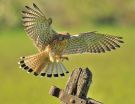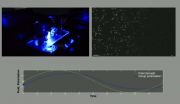Tiny but precise: The most accurate quantum thermometers
2015-06-05
(Press-News.org) Scientists have defined the smallest, most accurate thermometer allowed by the laws of physics -- one that could detect the smallest fluctuations in microscopic regions, such as the variations within a biological cell.
The research, involving mathematicians at The University of Nottingham and published in the latest edition of the journal Physical Review Letters, focuses on the sensitivity of thermometers made up of just a handful of atoms and small enough to exhibit distinctive 'quantum' features.
Devising sensitive and practical nano-scale thermometers would represent a huge leap forward as such technology would enable a plethora of applications in bioscience, chemistry, physics and in the diagnosis and treatment of many diseases.
The study was conducted as part of an ongoing collaboration between the Quantum Correlations Group in Nottingham's School of Mathematical Sciences and the Quantum Information Group at Universitat Autònoma de Barcelona.
Dr Gerardo Adesso, who led Nottingham's involvement in the study, said: "In this work we provide a full characterisation of those probes that estimate temperature with maximum accuracy and also the margin of error that must accompany any temperature estimate. To that end, we combine the tools of thermodynamics and 'quantum metrology', which deals with ultra-precise measurements on quantum systems, finding beautiful and insightful connections between the two."
The academics also illustrate how by sacrificing some accuracy it is possible to gain other desirable features in a thermometer, such as a constant sensitivity over a wide range of temperatures.
Finally, they also looked at the maximum accuracy achievable in realistic situations in which the time available for the temperature measurement may be short due to unavoidable experimental limitations.
INFORMATION:
The study was funded by the European Research Council, which provides grants for scientific projects that enable Europe's brightest minds to tackle research challenges such as climate change, health and ageing and economic governance.
ELSE PRESS RELEASES FROM THIS DATE:
2015-06-05
Honest behavior is much like sticking to a diet. When facing an ethical dilemma, being aware of the temptation before it happens and thinking about the long-term consequences of misbehaving could help more people do the right thing, according to a new study.
The study, "Anticipating and Resisting the Temptation to Behave Unethically," by University of Chicago Booth School of Business Behavioral Science and Marketing Professor Ayelet Fishbach and Rutgers Business School Assistant Professor Oliver J. Sheldon, was recently published in the Personality and Social Psychology ...
2015-06-05
This news release is available in German. Most magnetic materials have a structure that is somewhat more complicated than a commercially available domestic magnet: they not only have a north and south pole, but a variety of sectors, often only a few nanometres in size, in each of which the magnetic axis points in a different direction. These sectors are referred to as domains. Over the past few years, Manfred Fiebig, Professor for Multifunctional Ferroics at ETH Zurich, has been studying the walls between adjoining domains in certain materials. "The inner workings of ...
2015-06-05
When a woman becomes pregnant or is planning a pregnancy, one of her first decisions is where she will deliver her baby. With options ranging from birthing centers to small community hospitals to regional health networks to academic medical centers, the decision can be confusing.
The question, especially for a woman with a low-risk pregnancy, is "What is the likelihood that something could go wrong?"
Research on this topic has been published in the American Journal of Obstetrics & Gynecology. The research was conducted by Valery A. Danilack, MPH, PhD, postdoctoral ...
2015-06-05
Researchers from the UAB and the University of Nottingham, in an article published today in Physical Review Letters, have fixed the limits of thermometry, i.e., they have established the smallest possible fluctuation in temperature which can be measured. The researchers have studied the sensitivity of thermometers created with a handful of atoms, small enough to be capable of showing typical quantum-style behaviours.
The researchers characterised these types of probes in detail, devices which could provide an estimation of the temperature with a never before seen precision. ...
2015-06-05
June 5, 2015 - Young infants who can "resettle" themselves after waking up are more likely to sleep for prolonged periods at night, according to a video study in the June Journal of Developmental & Behavioral Pediatrics, the official journal of the Society for Developmental and Behavioral Pediatrics. The journal is published by Wolters Kluwer.
"Infants are capable of resettling themselves back to sleep by three months of age," according to the study by Ian St James-Roberts and colleagues of the University of London. They add, "Both autonomous resettling and prolonged ...
2015-06-05
Nanofibers -- polymer filaments only a couple of hundred nanometers in diameter -- have a huge range of potential applications, from solar cells to water filtration to fuel cells. But so far, their high cost of manufacture has relegated them to just a few niche industries.
In the latest issue of the journal Nanotechnology, MIT researchers describe a new technique for producing nanofibers that increases the rate of production fourfold while reducing energy consumption by more than 90 percent, holding out the prospect of cheap, efficient nanofiber production.
"We have ...
2015-06-05
One mystery of birds' flight is solved! The elegance of birds' flight, their seemingly effortless aerial turns and the softness of their landing, have been envied by many people. From countless observations, it has been known that the birds use a small group of feathers, called "the alula", a thumb-like structure that is present at the bend of the wing, in slow and steep flight such as landing. Why do they use it? How the tiny feathers can help them land softly?
A recent article published in Scientific Reports says that the secret is a small vortex of air that is formed ...
2015-06-05
Researchers from Uppsala University, together with colleagues at University College Dublin, have studied the dynamics of active swarms using computer simulations and experiments on unicellular algae. The team not only found full analogy of the active motion in a field to magnetic hysteresis but also managed to quantify the controllability of the swarm and identify the signatures of collective behavior of the active agents.
Active motion of living organisms and artificial self-propelling particles has been an
area of intense research at the interface of biology, chemistry ...
2015-06-05
Dublin, June 4th 2015 - Biochemists from Trinity College Dublin have devised a new technique that will make the difficult but critical job of blueprinting certain proteins considerably faster, cheaper and easier.
The breakthrough will make a big splash in the field of drug discovery and development, where precise protein structure blueprints can help researchers understand how individual proteins work. Critically, these blueprints can show weaknesses that allow drug developers to draw up specific battle plans in the fight against diseases and infections.
Professor ...
2015-06-05
Eye contact plays a crucial role when people initiate interaction with other people. If people look each other in the eye, they automatically send a signal that their attention is focused on the other person. If the other person happens to look back, the two will be in eye contact, and a channel for interaction is opened. Eye contact is thus a powerful social signal, which is known to increase our physiological arousal.
Previous research has suggested that eye contact triggers patterns of brain activity associated with approach motivation, whereas seeing another person ...
LAST 30 PRESS RELEASES:
[Press-News.org] Tiny but precise: The most accurate quantum thermometers


